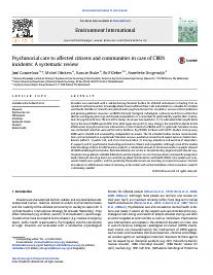Psychosocial care to affected citizens and communities in case of CBRN incidents: A systematic review
Disasters are associated with a substantial psychosocial burden for affected individuals (including first responders) and communities. Knowledge about how to address these risks and problems is valuable for societies worldwide. Decades of research into post-disaster psychosocial care has resulted in various recommendations and general guidelines. However, as CBRN (chemical, biological, radiological, nuclear) events form a distinctive theme in emergency planning and disaster preparedness, it is important to systematically explore their implications for psychosocial care. The aimof this study is to answer two questions: 1). Towhat extent does psychosocial care in the case of CBRN events differ fromother types of events? 2). How strong is the scientific evidence for the effectiveness of psychosocial care interventions in the context of a CBRN event? A systematic literature review was conducted. Searches were performed in Medline, PsychINFO, Embase and PILOTS. Studies since January 2000 were included and evaluated by independent reviewers. The 39 included studies contain recommendations, primarily based on unsystematic literature reviews, qualitative research and expert opinions. Recommendations address: 1) public risk- and crisis communication, 2) training, education and exercise of responders, 3) support, and 4) psychosocial counselling and care to citizens and responders. Although none of the studies meet the design criteria for effectiveness research, a substantial amount of consensus exists on aspects relevant to CBRN related psychosocial care. Recommendations are similar or complementary to general post-disaster psychosocial care guidelines. Notable differences are the emphasis on risk communication and specific preparation needs. Relevant recurring topics are uncertainty about contamination and health effects, how people will overwhelm health care systems, and the possibility that professionals are less likely to respond. However, the lack of evidence on effectiveness makes it necessary to be careful with recommendations. More evaluation research is absolutely needed.
Geachte bezoeker,
De informatie die u nu opvraagt, kan door psychotraumanet niet aan u worden getoond. Dit kan verschillende redenen hebben,
waarvan (bescherming van het) auteursrecht de meeste voorkomende is. Wanneer het mogelijk is om u door te verwijzen naar de bron
van deze informatie, dan ziet u hier onder een link naar die plek.
Als er geen link staat, kunt u contact opnemen met de bibliotheek,
die u verder op weg kan helpen.
Met vriendelijke groet,
Het psychotraumanet-team.
Reference:
Juul Gouweloos, Michel Dückers, Hans te Brake, Rolf Kleber, Annelieke Drogendijk | 2014
In: Environment international : a journal of environmental science, risk & health, ISSN 1873-6750 | 72 | november | 46–65
http://www.sciencedirect.com/science/article/pii/S0160412014000592
In: Environment international : a journal of environmental science, risk & health, ISSN 1873-6750 | 72 | november | 46–65
http://www.sciencedirect.com/science/article/pii/S0160412014000592


